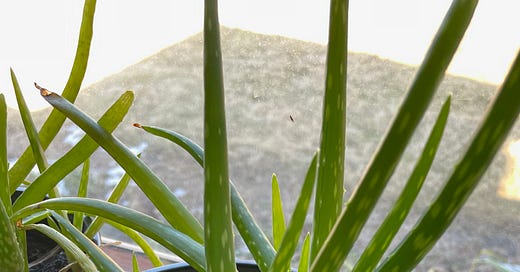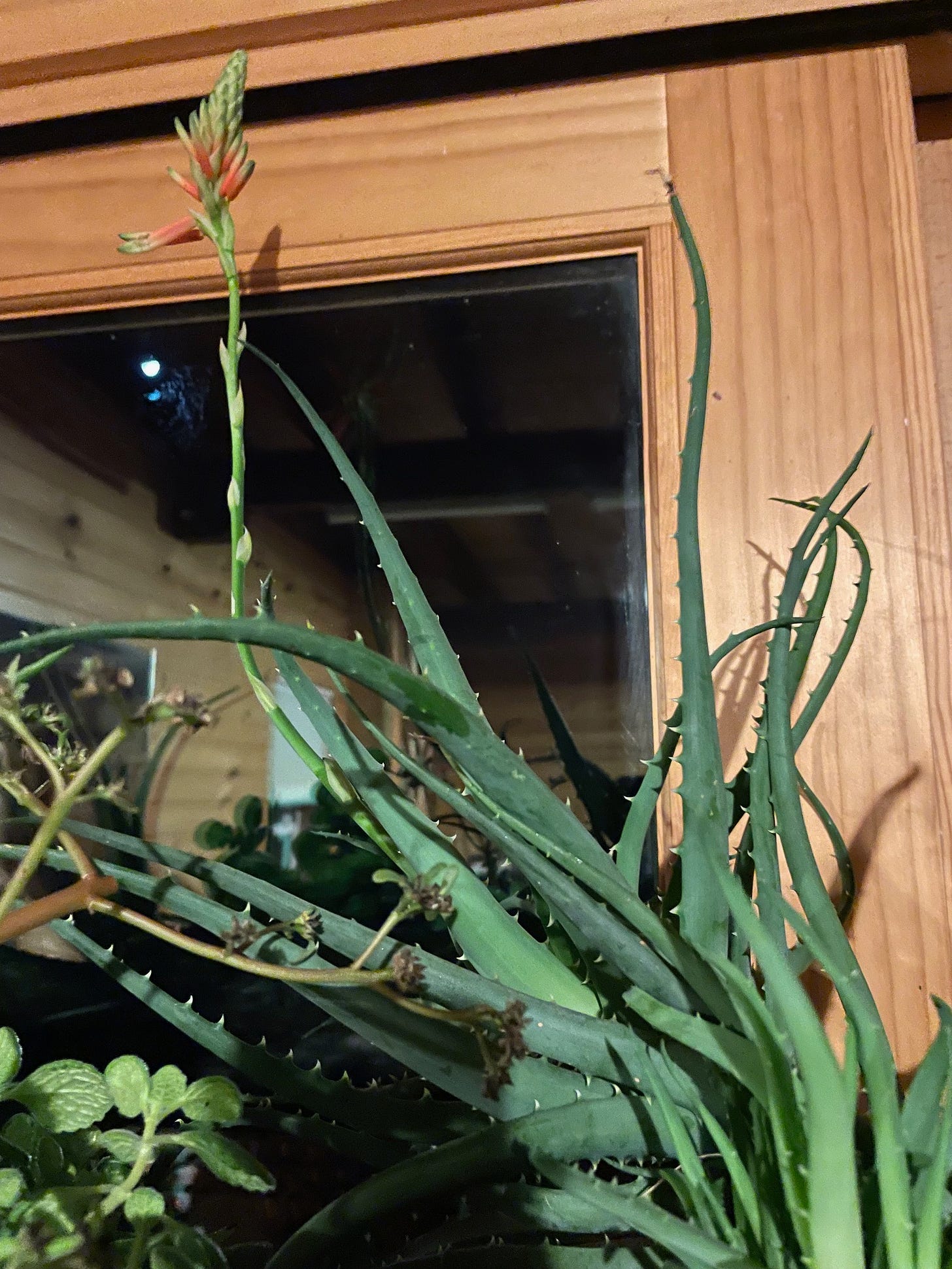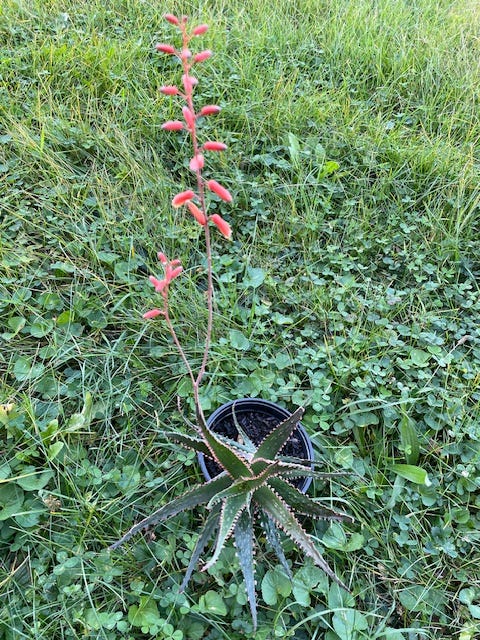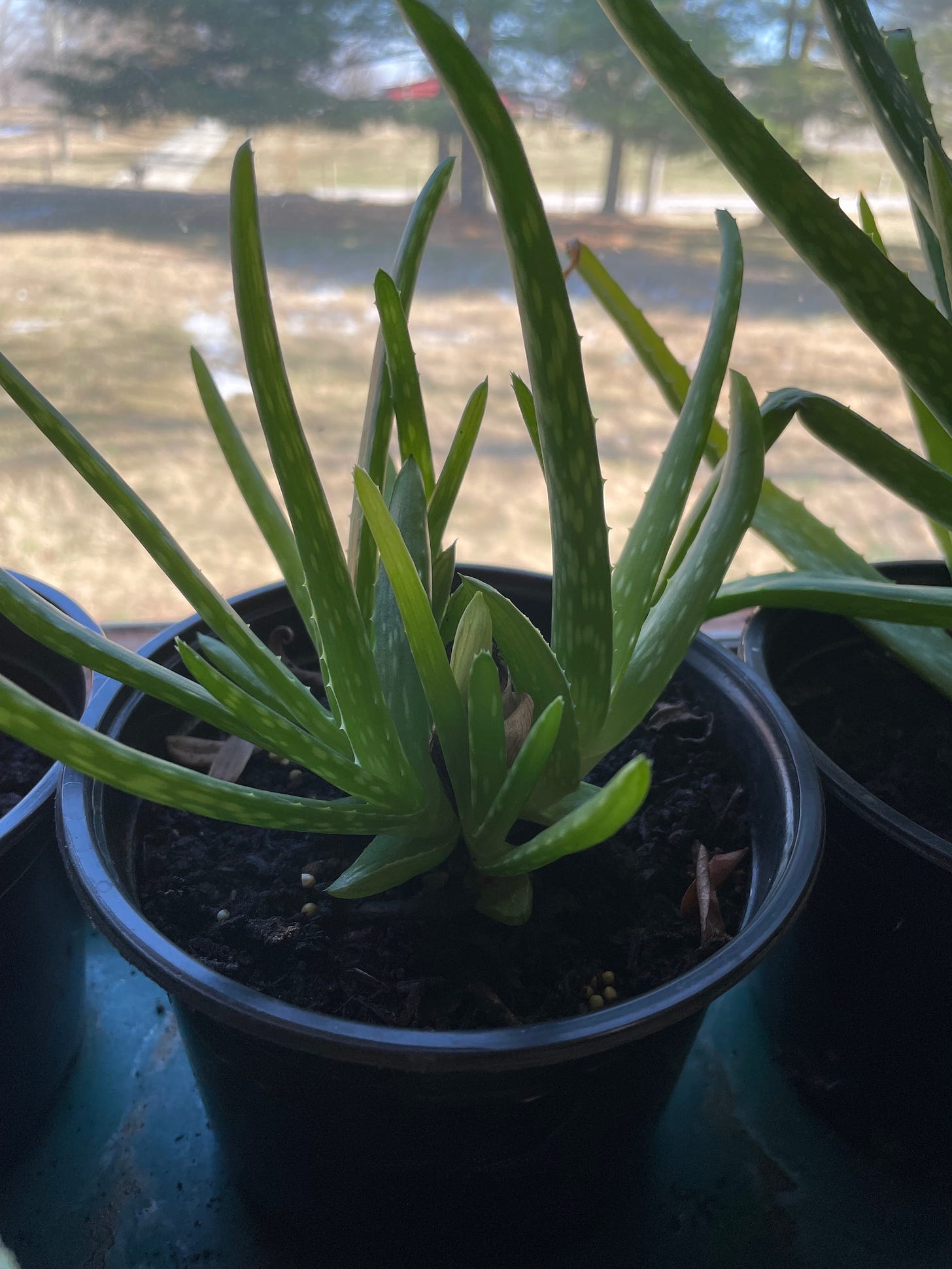At weedom, we can get our thrills from simple things, and blooming Aloe supplied some jollies last year. Most of our Aloes have never bloomed, but one of our plants put on a 2 month show during winter of 2022 to 2023, as a stalk emerged and showed signs that it might bloom. And flower it did, for about 8 weeks, starting at the lower end, and gradually opening up to the tip.
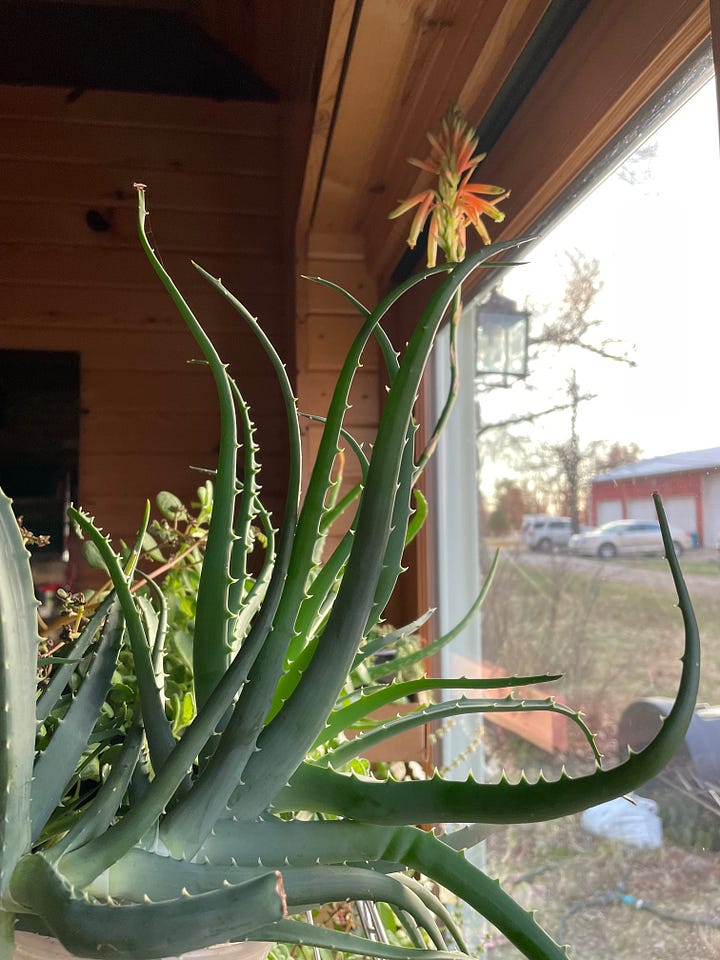
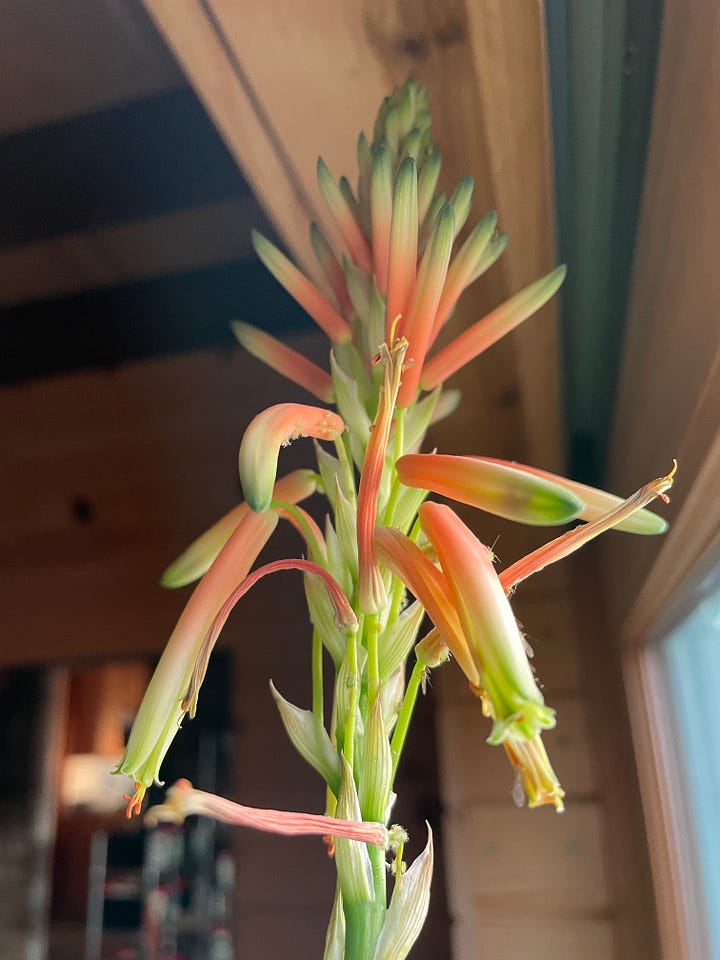
At the end of summer, 2023, one of our smaller aloes surprised us with a blooming stalk after suffering significant neglect on the north side of our house.
We have observed that aloes seem inclined towards reproductive efforts when conditions are dire. For example, the most common Aloe vera will produce little clones of itself when it suffers extreme dryness.
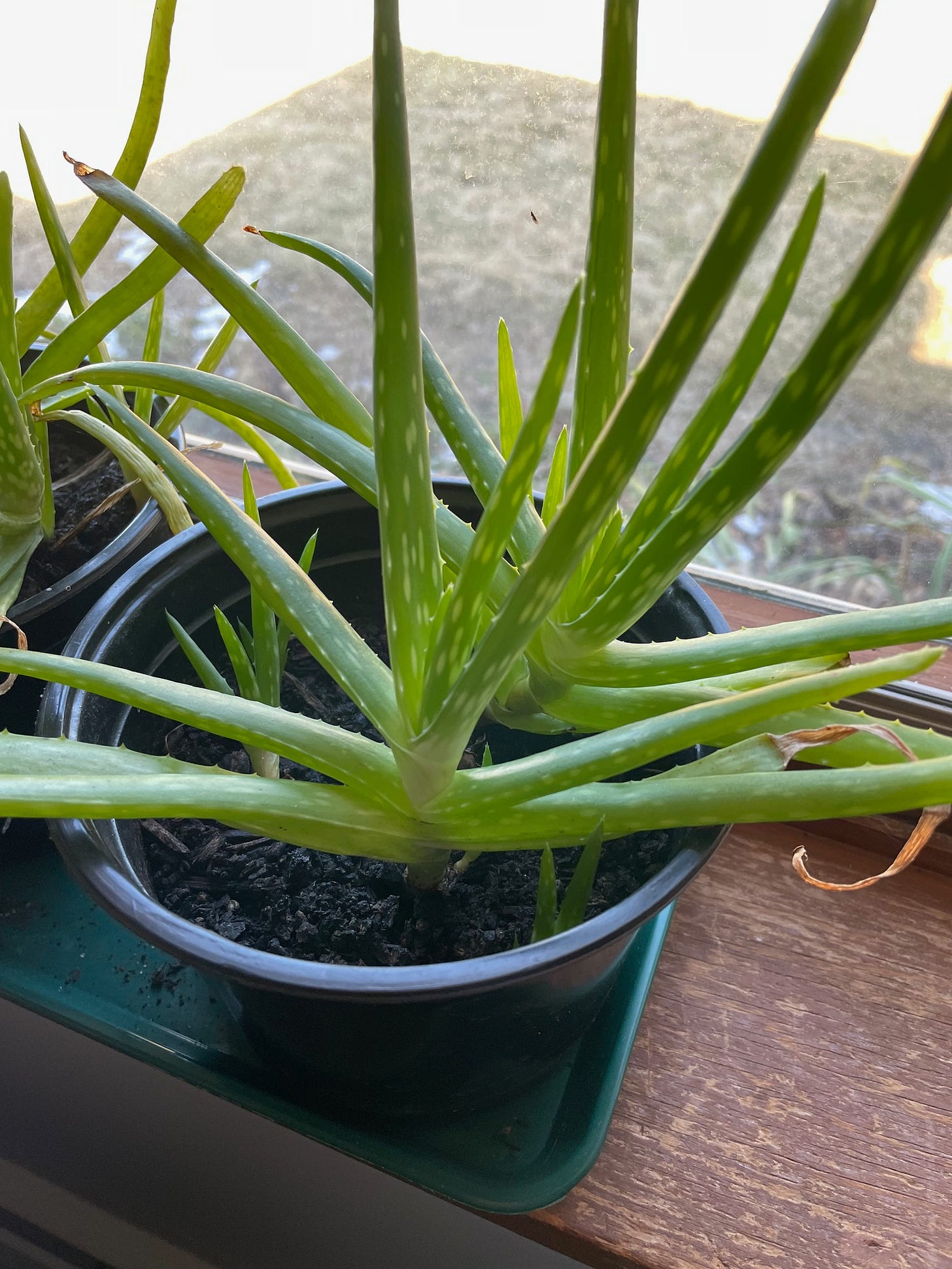
Here in winter the air is desert-like and these plants get watered every 2 weeks or so. We’ll have plenty of new sprouted plants for the growing season. It doesn’t take long for them to get huge.
Chopping off an Aloe just above ground level is pretty efficient to stimulate new growth.
So if you have a leggy or spindly aloe plant, you can chop it low, trim off most of the central stem part, and let the top portion air dry for a week or two, til the cut end is sealed. Then plug the end into moist dirt. It’ll take root and look great again. We sent the top portion of the above plant to a new home, once it rooted and grew, and kept the base for ourselves. Wish there were pics of that whole process, but who can know when it’s time to write about aloe? It just happens.
Our usual habit is to grow aloes, harvest or rehome the big ones, and keep a bunch of smaller ones inside through the winter, since we have a fairly small, indoor growing area.
This plant was simply the ‘tremendous topical burn weed’ to years ago, but we learned that it has myriad uses inside and out. Many of the common aloes are useful for burns, but they vary in their ability to be used internally. And one must be attentive to which part of the plant is used. It’s hard to know how anyone counted, but there’s said to be about 500 species in the Aloe genus (family Asphodeloideae). Add to that innumerable hybrids. Use of the plant dates back to about 6000 years, in Egypt where the juice was considered nourishing. Anti-inflammatory and pain mitigating properties were noted there as early as 1500 BC.
Aloe vera is the name applied to Aloe barbadensis, Aloe vera barbadensis Miller, or as Aloe vera, var. chinensis, Aloe perfoliata var. vera, Aloe perfoliata var. barbadensis, and so on and so forth. Some regard Aloe vera, var. chinensis as a variety (not a different species) that retains its white spots on the leaves even when mature, and consider it to be less edible (more laxative) than Aloe vera barbadensis Miller. We’ve never seen this happen at weedom, but the Aloe vera barbadensis Miller will put up a stem bearing a raceme of yellow tubular flowers under the right conditions, and this differs from the chinensis variety which produces orange flowers. This is because we don’t keep the large, Aloe vera plants until they’re old enough to flower. These perennial plants can live for 20 or more years, and often take a few years to produce their first blooms. The Aloe vera plants at weedom tend to lose their spots, even within the first year, so they’re the more edible type.
Aloe vera is thought to have originated in a mountainous region of Oman, on the Arabian peninsula, but is now grown in landscapes within hardiness zones 9-11 or so, and in houses everywhere. Aloes in general do not like temperatures below 45 degrees. They can tolerate dry conditions during the cooler portion of the year, and will grow rapidly with sufficient water during the hotter months. They need well drained soil, to prevent root rot. Aloe can be propagated most easily by dividing and replanting the suckers, but also by seeds from the tubular flowers which possess both male and female parts.
The stimulant laxative quality of aloe species is attributed to anthroquinones within the latex sap. Each fleshy leaf has three layers:
an outer rind which serves as protection, and contains the vascular bundles which transport fluids and nutrients throughout the leaf
a middle layer with most of the latex sap containing bitter compounds including the irritant and laxative anthroquinones.
an inner layer containing the gel consisting of a 99% water matrix containing vitamins, lipids, sterols, glucomannans, and amino acids.
Cutting off the leaf portion up to 1 inch away from the stem is a good way to avoid much of the irritant latex. Also cut off the tip of the leaf if you’d like to drain out latex before harvesting the gel. To remove the most bitterness from edible aloe, soak the cut leaves in water, then separate the gel from the green rind of the leaf, lengthwise using the dull side of a knife. The gel can then be soaked again in fresh water before it is used in whatever recipe or smoothie you choose. The extra soaking steps will assure a much better flavored product for nutritional use, or for application to address dental issues. A detailed vid showing a harvesting procedure can be found here, and linked below.
Aloe differs from many traditionally herbs in that there are numerous studies of medicinal use in humans, topically and internally, and it is currently in massive commercial use around the world, for everything from cosmetics to lowering blood sugar. One of our farmers’ market buddies is a true Aloe enthusiast. He reports success with addressing pain, burns, and with blood sugar control, and his stories provided inspiration for presenting this plant, even though it’s not a local weed, and has no chance of naturalizing in our zone 6. There are published studies in which concur with his results, showing stimulation of insulin production, and lowering of blood sugar in rats, and lowering of blood glucose and hemoglobin A1C in humans, with the internal use of Aloe extract. Lowering of total cholesterol, LDL and triglycerides has also been observed in human trials.
Pain relieving qualities of Aloe are attributed to various antinflammatory activities including inhibiting the cyclooxygenase pathway of prostaglandin biosynthesis, which may in part be attributed to the presence of salicylic acid. A bradykinase enzyme, plant sterols, and anthraquinones such as Aloe emodin also contribute to anti-inflammatory effects.
Aloe has also produced positive results in the reduction of peridontal disease in humans, healing of oral ulcers, accelerated recovery from oral surgery, and reduction of pain after tooth extraction. Mixed results were obtained in studies of chemotherapy induced oral mucositis.
Gastroesophageal reflux symptoms were alleviated by Aloe in a study comparing it with ranitadine and esomeprazole, but that was an open label trial. An observational trial suggested that Aloe was effective in addressing pain and bleeding of anal fissue, and accelerated the healing. A double blind randomized trial showed Aloe to reduce the symptoms of irritable bowel syndrome.
Part of the success seen with Aloe vera in dental disease might be due to its antimicrobial activities against many bacterial pathogens commonly found in the mouth and GI tract. The gel from the inner leaf also exhibits antiviral and antifungal activities.
Antimalarial activity of Aloe has been correlated with high aloin and aloe-emodin content, which inhibited a strain of Plasmodium falciparum that was also chloroquine sensitive. (Aloin, emodin and aloe-emodin contribute to the laxtive effect of Aloe, but their concentration is reduced by the harvesting methods mentioned above. There are good reasons to restrict the use of stimulant laxatives of this nature.)
The acemannan and fructans present in Aloe vera gel are proposed as being potentially beneficial as prebiotics based on in vitro stimulation of Bifidobacterium species proliferation. This and the calcium, magnesium, beta-carotene, vitamin C, and various other antioxidants are reasons to consider keeping this plant around the house and adding some of the gel to your smoothies.
Is Aloe vera a part of your nutritional or skin care regime? Let us know what you think!
Where We Dig
1. Bell M. 4 Proven Benefits of Aloe Vera Juice in Joint Pains. Published February 25, 2015. Accessed February 22, 2024. https://healthyy.net/superfoods/aloe-vera-juice-for-joint-pain
2. 13 Effective Uses & Benefits of Aloe Vera! - PharmEasy Blog. Accessed February 22, 2024. https://pharmeasy.in/blog/aloe-vera-gel-uses-and-uses/
3. 21 Types of Aloe Plants: Identification and Care Tips. The Spruce. Accessed February 20, 2024. https://www.thespruce.com/types-of-aloe-plants-4586709
4. Quezada MP, Salinas C, Gotteland M, Cardemil L. Acemannan and Fructans from Aloe vera (Aloe barbadensis Miller) Plants as Novel Prebiotics. J Agric Food Chem. 2017;65(46):10029-10039. doi:10.1021/acs.jafc.7b04100
5. Aloe vera (Aloe, Aloe Vera, Barbados Aloe, Medicinal Aloe, Medicine Plant, True Aloe) | North Carolina Extension Gardener Plant Toolbox. Accessed February 22, 2024. https://plants.ces.ncsu.edu/plants/aloe-vera/
6. Rojas-Sandoval J. Aloe vera (true aloe). CABI Compendium. 2017;CABI Compendium:4192. doi:10.1079/cabicompendium.4192
7. Surjushe A, Vasani R, Saple DG. Aloe vera: a Short Review. Indian J Dermatol. 2008;53(4):163-166. doi:10.4103/0019-5154.44785
8. Rahmani AH, Aldebasi YH, Srikar S, Khan AA, Aly SM. Aloe vera: Potential candidate in health management via modulation of biological activities. Pharmacogn Rev. 2015;9(18):120-126. doi:10.4103/0973-7847.162118
9. Fan JJ, Li CH, Hu G, et al. Comparative Analysis of Soluble Proteins in Four Medicinal Aloe Species by Two-Dimensional Electrophoresis and MALDI-TOF-MS. J AOAC Int. 2019;102(3):748-760. doi:10.5740/jaoacint.18-0310
10. Hsiu-Mei Chiang, Ya-Tze Lin, Pei-Ling Hsiao, Yu-Han Su, Hui-Ting Tsao, Kuo-Ching Wen. Determination of Marked Components - aloin and aloe-emodin - in Aloe vera before and after hydrolysis. 藥物食品分析. 2012;20(3). doi:10.6227/jfda.2012200311
11. Babaee N, Zabihi E, Mohseni S, Moghadamnia AA. Evaluation of the therapeutic effects of Aloe vera gel on minor recurrent aphthous stomatitis. Dent Res J (Isfahan). 2012;9(4):381-385.
12. Liu C, Cui Y, Pi F, Cheng Y, Guo Y, Qian H. Extraction, Purification, Structural Characteristics, Biological Activities and Pharmacological Applications of Acemannan, a Polysaccharide from Aloe vera: A Review. Molecules. 2019;24(8):1554. doi:10.3390/molecules24081554
13. How to Best Prepare and Eat Aloe Vera & Aloe FAQ.; 2014. Accessed February 22, 2024.
14. Identifying and Growing Edible Aloe Vera. Deep Green Permaculture. Published April 15, 2019. Accessed February 20, 2024. https://deepgreenpermaculture.com/2019/04/16/identifying-and-growing-edible-aloe-vera/
15. (PDF) Oral Aloe vera as a treatment for osteoarthritis: A summary. Accessed February 22, 2024. https://www.researchgate.net/publication/45462118_Oral_Aloe_vera_as_a_treatment_for_osteoarthritis_A_summary
16. Sánchez M, González-Burgos E, Iglesias I, Gómez-Serranillos MP. Pharmacological Update Properties of Aloe Vera and its Major Active Constituents. Molecules. 2020;25(6):1324. doi:10.3390/molecules25061324
17. Nowak-Perlak M, Bromke MA, Ziółkowski P, Woźniak M. The Comparison of the Efficiency of Emodin and Aloe-Emodin in Photodynamic Therapy. Int J Mol Sci. 2022;23(11):6276. doi:10.3390/ijms23116276


